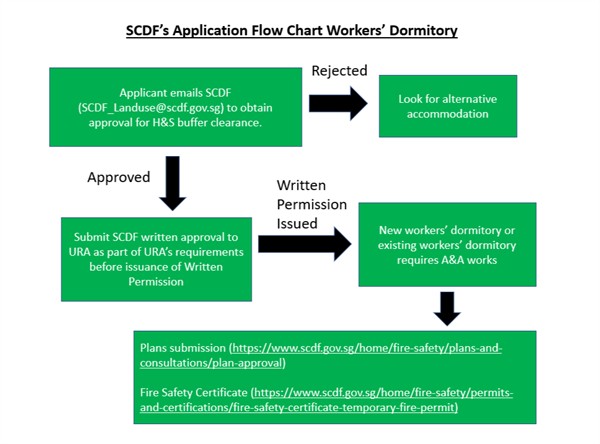Safety Considerations for Workers’ Dormitories
For companies planning to handle/store hazardous substances and flammable materials, agencies (SCDF, NEA) may require a Quantitative Risk Assessment (QRA) study to be carried out. Based on the QRA study, Health & Safety (H&S) buffer may be generated based on the projected consequence of potential fire, explosion and/or release of toxic gases from the said company.
Due to safety reasons, agencies (SCDF, NEA, MOM, JTC, URA) do not allow workers’ dormitories to be sited within existing H&S buffer because workers may not be in a state of alertness at night (e.g. sleeping) to carry out the necessary protective actions such as evacuation or In-Place-Protection (IPP), when a major incident occurs.
For applications that are not supported due to H&S buffer, applicant is advised to look for alternative accommodation for your workers at other locations. You may refer to MOM’s website on Housing for Foreign Workers for more information on the various types of housing available such as secondary Factory Converted Dormitories (FCDs) and Purpose Built Dormitories (PBDs).
SCDF’s Application Flow Chart for Workers’ Dormitory

To seek SCDF’s approval on the Health & Safety (H&S) buffer, please email to SCDF_Landuse@scdf.gov.sg
Click on the links to find out more on SCDF’s Plan Approval and Fire Safety Certificate.
Various types of housing and their specific requirements
There are various types of housing that your foreign employees can live in, each with its own set of requirements. Employers must carry out due diligence to ensure these requirements are met. Employers who fail to do so may be prosecuted, and disallowed to hire foreign employees.
Announcement of New Dormitory Standards
The new dormitory standards aim to strengthen resilience against future pandemics and improve living conditions of migrant workers.
- It applies to all new dormitories, including:
- Purpose-Built Dormitories (PBDs)
- Factory-Converted Dormitories (FCDs)
- Construction Temporary Quarters (CTQs)
- Temporary Occupation Licence Quarters (TOLQs)
Which dormitories must comply with the new dormitory standards?
| For | The dormitory |
|---|---|
| Existing or upcoming dormitories approved before 18 September 2021 |
|
| New dormitories that have applied to relevant agencies for approval on or after 18 Sep 2021 | Must comply with the new dormitory standards. |
Purpose-Built Dormitories (PBDs)
| What are PBDs | PBDs are specially designed and built with features to meet the needs of foreign employees:
|
|---|---|
| Allowed to house | All foreign employees. |
We highly recommend you to:
- Sign a written tenancy agreement with the dormitory operator.
- Provide ways for employees to highlight problems with the housing to the dormitory operator, and work with the dormitory operator to rectify them.
Factory-Converted Dormitories (FCDs)
| What are FCDs | Industrial or warehouse developments which have been partially converted to dormitories. |
|---|---|
| Types of FCDs allowed |
|
| Maximum permissible occupancy | 300 Appeals for higher permissible occupancy will be assessed on a case-by-case basis. To appeal, provide these information:
|
| What are Standalone Temporary Quarters | Any structure used for housing employees within a construction site that will eventually be demolished or removed. |
|---|---|
| Allowed to house | Construction sector foreign employees working at that particular construction project |
| Maximum permissible occupancy | 300 Appeals for higher permissible occupancy will be assessed on a case-by-case basis. To appeal, provide these information:
|
| What are quarters in uncompleted permanent building | They are parts of buildings still under construction that are used for employees’ quarters. |
|---|---|
| Allowed to house | Construction sector foreign employees working at that particular construction project. |
| Maximum permissible occupancy | 300 Up to 6 persons in residential units under construction. Appeals for higher permissible occupancy will be assessed on a case-by-case basis. To appeal, provide these information:
|

No comments:
Post a Comment